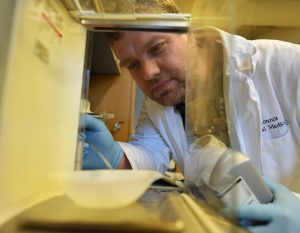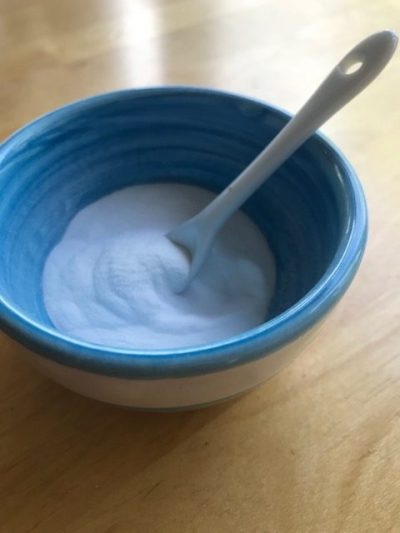Is it crazy to think that something as simple as a daily dose of baking soda could significantly lower the damage caused by inflammation and autoimmune response for diseases like rheumatoid arthritis? It’s not crazy at all, say researchers from the Medical College of Georgia.
Their study, published in the Journal of Immunology, showed that when rats or healthy people drink a solution of baking soda, NaHCO3, it becomes a trigger for the stomach to make more acid to digest the next meal and, more importantly it also tells the mesothelial cells, sitting on the spleen, to tell the organ that there’s no need to mount a protective immune response. It’s this communication trigger that is so profound. Instead of telling the spleen that a food is a foreign invader, it hears this is a good thing.
It’s most likely a hamburger not a bacterial infection,” is basically the message, says Dr. Paul O’Connor, renal physiologist in the MCG Department of Physiology at Augusta University and the study’s corresponding author.
How NaHCO3 Affects Autoimmune Response
O’Connor and his team made this discovery while considering the role of mesothelial cells that cover the 
Drinking baking soda, the MCG scientists think, tells the spleen to go easy on the immune response. “Certainly drinking bicarbonate affects the spleen and we think it’s through the mesothelial cells,” O’Connor says. The conversation, which occurs with the help of the chemical messenger acetylcholine, appears to promote a landscape that shifts against inflammation, they report.
In the spleen, as well as the blood and kidneys, they found after drinking water with baking soda for two weeks, the population of immune cells called macrophages, shifted from primarily those that promote inflammation, called M1, to those that reduce it, called M2. Macrophages, perhaps best known for their ability to consume garbage in the body like debris from injured or dead cells, are early arrivers to a call for an immune response.
In the case of the lab animals, the problems were hypertension and chronic kidney disease, problems which got O’Connor’s lab thinking about baking soda. One of the many functions of the kidneys is balancing important compounds like acid, potassium and sodium. With kidney disease, there is impaired kidney function and one of the resulting problems can be that the blood becomes too acidic, O’Connor says. Significant consequences can include increased risk of cardiovascular disease and osteoporosis.
It sets the whole system up to fail basically,” O’Connor says. Clinical trials have shown that a daily dose of baking soda can not only reduce acidity but actually slow progression of the kidney disease, and it’s now a therapy offered to patients. “We started thinking, how does baking soda slow progression of kidney disease?” O’Connor says. That’s when the anti-inflammatory impact began to unfold as they saw reduced numbers of M1s and increased M2s in their kidney disease model after consuming the common compound.
When they looked at a rat model without actual kidney damage, they saw the same response. So the basic scientists worked with the investigators at MCG’s Georgia Prevention Institute to bring in healthy medical students who drank baking soda in a bottle of water and also had a similar response. “The shift from inflammatory to an anti-inflammatory profile is happening everywhere,” O’Connor says. “We saw it in the kidneys, we saw it in the spleen, now we see it in the peripheral blood.”
The shifting landscape, he says, is likely due to increased conversion of some of the proinflammatory cells to anti-inflammatory ones coupled with actual production of more anti-inflammatory macrophages. The scientists also saw a shift in other immune cell types, like more regulatory T cells, which generally drive down the immune response and help keep the immune system from attacking our own tissues. That anti-inflammatory shift was sustained for at least four hours in humans and three days in rats.
The shift ties back to the mesothelial cells and their conversations with our spleen with the help of acetylcholine. Part of the new information about mesothelial cells is that they are neuron-like, but not neurons O’Connor is quick to clarify. “We think the cholinergic (acetylcholine) signals that we know mediate this anti-inflammatory response aren’t coming directly from the vagal nerve innervating the spleen, but from the mesothelial cells that form these connections to the spleen,” O’Connor says.
In fact, when they cut the vagal nerve, a big cranial nerve that starts in the brain and reaches into the heart, lungs and gut to help control things like a constant heart rate and food digestion, it did not impact the mesothelial cells’ neuron-like behavior. The affect, it appears, was more local because just touching the spleen did have an effect.
When they removed or even just moved the spleen, it broke the fragile mesothelial connections and the anti-inflammatory response was lost, O’Connor says. In fact, when they only slightly moved the spleen as might occur in surgery, the previously smooth covering of mesothelial cells became lumpier and changed colors.
“We think this helps explain the cholinergic (acetylcholine) anti-inflammatory response that people have been studying for a long time,” O’Connor says. Studies are currently underway at other institutions that, much like vagal nerve stimulation for seizures, electrically stimulate the vagal nerve to tamp down the immune response in people with rheumatoid arthritis.
While there is no known direct connection between the vagal nerve and the spleen – and O’Connor and his team looked again for one – the treatment also attenuates inflammation and disease severity in rheumatoid arthritis, researchers at the Feinstein Institute for Medical Research reported in 2016 in the journal Proceedings of the National Academy of Sciences. O’Connor hopes drinking baking soda can one day produce similar results for people with autoimmune disease.
“You are not really turning anything off or on, you are just pushing it toward one side by giving an anti-inflammatory stimulus,” he says, in this case, away from harmful inflammation. “It’s potentially a really safe way to treat inflammatory disease.”
The spleen also got bigger with consuming baking soda, the scientists think because of the anti-inflammatory stimulus it produces. Infection also can increase spleen size and physicians often palpate the spleen when concerned about a big infection.
This article was edited from the original version, by Toni Baker,Communications Director at the Medical College of Georgia at Augusta University.





